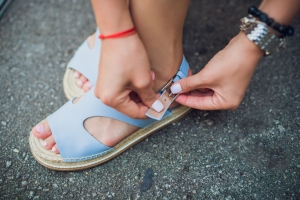Connect With Us
Blogs
Displaying items by tag: foot conditions
Summer Shoe Do’s and Don’ts
At Superior Foot & Ankle Care Center we know that many of our Los Angeles County patients welcome the summer season and the shoe wardrobe that accompanies it. While it’s always fun to wear fashionable footwear that suits the season our podiatrists, Dr. Victoria M. Foley and Dr. Constance Ornelas, always have the health and safety of your feet as a top priority. Below are some do’s and don’ts to consider when making summer shoe choices:
Do: contact our Long Beach office at (562) 420-9800 to schedule an appointment with our podiatrists if you have a chronic foot condition and require specific shoe style recommendations.
Do: make sure all your summer shoes fit properly. Discard shoes that hurt your feet whenever you wear them. Get your feet professionally measured when buying new summer shoes.
Do: use flip flops around the town pool, at the beach and other public places where there are lots of bare feet. This will help prevent common fungal infections like athlete’s foot and toenail fungus. Don’t use these shoes as your daily summer footwear choice, however, unless you buy upgraded versions that feature arch support and more structure to prevent injuries.
Don’t: forget to apply sunscreen to your feet when wearing sandals and other open styles that expose the skin on your feet.
Do: consider wedge-style heels over spikes for greater stability and reduced risk of ankle sprains.
Do: alternate the heel heights on the shoes you wear to prevent repetitive strain on your Achilles tendon and calf muscles. Avoid heels that are over two inches.
Don’t: wear flats for heavy walking days. While they may feel comfortable initially, the lack of an arch will ultimately lead to heel pain and discomfort.
Don’t: wear flip-flops for beach volleyball or sandals for hiking. Always choose the right shoe for the activity you are doing.
Do: wear socks with your sneakers to prevent blisters and absorb sweat. Change your socks as soon as you notice they feel damp. Fungal infections thrive in moist, dark places.
Do: keep moleskin with you to apply to any spot on your foot that feels like it might be forming a blister.
Foot Disorders that Sound Scary (but Aren’t!)
At Superior Foot & Ankle Care Center we thought we’d get into the spirit of Halloween for our Los Angeles County patients by exploring some foot problems that have frightening names. If our podiatrists, Dr. Victoria M. Foley and Dr. Constance Ornelas told you that you had one of the disorders named below, you might panic. But in reality, these are just the medical names for some fairly common and easily treatable conditions. And, our friendly podiatrists would most likely tell you the “user-friendly” name of your foot problem to avoid alarming you!
Tinea Pedis—You’d probably be less scared if you heard “athlete’s foot,” the common name for this itchy skin problem. Often beginning between your toes, the skin will be red, itchy, and flaky. In advanced cases, oozing blisters and cracks in the skin may develop. There are a number of topical treatments that the foot doctor may prescribe to eliminate athlete’s foot. Of course, it’s better to avoid contracting it in the first place. To prevent athlete’s foot, wear shower shoes when walking in public places like community pools and gyms, avoid items that touch another person’s foot, and keep feet dry.
Medial Tibial Stress Syndrome—You may experience this podiatric problem if you’ve recently started a new walking or running program. Its shorter name is “shin splints.” Telltale signs include pain, swelling, and tenderness in the front of the leg on either side of the shin bones. It’s important that you have your legs and feet examined by the foot doctor if you have shin splints because there are a number of different causes of this condition. Left untreated, the pain will get worse and may even lead to a stress fracture.
Onychomycosis—What does it mean when your toenails become discolored and get thick and crumbly? Most likely you’ve contracted toenail fungus—also known as onychomycosis. Fungal toenails are harder to get rid of than other fungal infections. The foot doctor will prescribe the best treatment option for you. We also offer KeryFlex Nail Restoration System to repair nails damaged by fungal infections.
We don’t ever want any of our patients to be fearful about seeing the podiatrist. If you notice anything that looks even a little frightful about your toes, feet or ankles make an appointment at our Long Beach office today by calling: (562) 420-9800.


